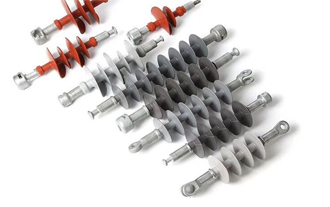03
Pollution discharge of pin insulator
Pin insulators pollution discharge refers to the pollution of the external insulation flashover of the equipment at the working voltage, and a certain discharge phenomenon when there is pollution.
In the natural environment, pin insulators are attacked by nitrogen oxides, salts, and particulate dust, and a layer of dirt is gradually deposited on the surface. When the weather is dry, these dirty insulators maintain a high insulation level, and their discharge voltage is close to that in the clean state. When encountering wet weather such as fog, dew, drizzle, and melting ice, melting snow, etc., the surface of the pin insulator absorbs moisture, the electrolyte in the polluted layer dissolves and ionizes, resulting in increased conductivity of the polluted layer, and the surface leakage current of the pin insulator increase.
Different structural forms and characteristics promote their different characteristics and performances. Due to the influence of the shape, structure and size of the pin insulator, as well as the uneven distribution of the pollution layer on the surface of the pin insulator and the different humidity levels, the current on various parts of the insulator surface The density is different. As a result, a drying belt is formed at a location where the current density is large. The formation of the drying belt causes the voltage distribution on the surface of the insulator to be more uneven, and the drying belt withstands a higher voltage. When the electric field strength is large enough, a glow discharge will occur, which in turn will produce a partial arc. The arc may be extinguished or it may develop. When the local arc continuously occurs and develops, reaching or exceeding the critical state, the arc penetrates the two poles, generating flashover.
The measures to prevent the pollution discharge of porcelain line post insulators are:
(1) Adjust the creepage distance of pin insulators, or use dust-proof insulators and silicon rubber insulators with strong anti-pollution ability;
(2) Purify the insulator and keep the surface of the insulator clean;
(3) A variety of antifouling paints are placed on the surface of the pin insulator;
(4) Various rain cover and silicone rubber increased climbing skirt;
(5) Adopt semiconductor glaze insulator;
(6) Strengthen the control efforts, regularly inspect the insulator string for zero quality and poor quality, and replace the zero value and poor quality insulators in time.

Composite Insulators
04
Composite pin insulator
Composite insulators are new products developed in recent years. Except for different connection methods, the structure is basically the same as rod-type composite insulators, so it has reliable internal insulation, lightweight, easy installation, impact resistance, and shock resistance. It has excellent explosion-proof performance, its bending and torsional strength can be designed to be higher, and it is an ideal replacement product for pin-type porcelain insulators.
The composite insulator is composed of three parts: glass fiber epoxy resin picking rod, silicon rubber umbrella skirt, and fittings. The silicon rubber umbrella skirt adopts the overall pressure injection process, thereby solving the key problem that affects the reliability of the composite insulator-interface electrical breakdown. The connection between the glass pull rod and the metal fittings adopts a unique glue installation process, which has high strength, beautiful appearance, small size, and lightweight. The metal fittings are galvanized to prevent corrosion and can be used interchangeably with porcelain insulators.
There are many products of composite pin insulators, and the meaning of the symbols in the model is illustrated as follows: FPQ4-10 / 3T20G
F represents compound, P represents needle type, Q represents anti-pollution (reinforced insulation) type;
4 represents the anti-pollution level;
10/3 indicates rated voltage (kV) / rated bending load (kN);
T-iron crossarm, L-glass steel crossarm, M-wood crossarm;
20- steel foot diameter (mm);
Color: not represented as dark red; H-gray; G-green.
The composite insulator has superior electrical performance, high mechanical strength, and the tensile strength of the epoxy glass fiber pick-up rod carried inside is 2 times higher than that of ordinary steel and 8-10 times that of high-strength ceramic materials, which effectively improves the reliability of safe operation.
It has good anti-pollution performance and strong anti-pollution flashover capability. Its wet withstand voltage and pollution withstand voltage is 2-2.5 times of the same creepage porcelain insulators, and it does not need to be cleaned. It can operate safely in heavily polluted areas.
Small size and lightweight (only 1 / 6-1 / 19 of the porcelain insulator of the same voltage level), light structure, easy to transport and install.
The silicone rubber umbrella skirt has good water-repellent properties, and its overall structure ensures that the inner insulating cloth is damp, no need for preventive insulation monitoring test, no cleaning, reducing the daily maintenance workload.
It has good sealing performance, strong resistance to electric corrosion and the umbrella skirt material has a tracking resistance of YMA4.5 level. It has good aging resistance, corrosion resistance, and low-temperature resistance. It can be applied to -40 ℃ ≈ + 50 ℃.
It has a strong impact resistance and shock resistance. It has good anti-brittleness and creeps resistance. It is not easy to break, bend, and torsion strength can withstand internal pressure, strong explosion-proof force, and can be interchanged with porcelain and glass insulator used. Composite insulators are superior to porcelain insulators in mechanical and electrical performance and have a large operating safety margin. They are newer products for power lines.
05
Low voltage pin insulator
Needle insulators for low-voltage distribution lines are available in PD-1 (2) T (M, W) and other models. 1, 2 is the number indicating the mechanical damage strength of the porcelain, No. 1 is not less than 8kN, No. 2 is not less than 5kN. T for iron crossarms, M for wooden crossarms, and W for bent legs.
+86 319 878 9350
+86 156 1304 7999
+86 319 878 9350
NanYan, DongHuan Road, Shahe, Hebei China
Copyright © Hebei Yipeng Line Equipment Co., Ltd. All Rights Reserved. | Sitemap Powered By 
